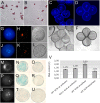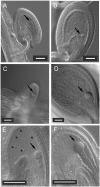The Arabidopsis thaliana F-box protein FBL17 is essential for progression through the second mitosis during pollen development
- PMID: 19277118
- PMCID: PMC2651519
- DOI: 10.1371/journal.pone.0004780
The Arabidopsis thaliana F-box protein FBL17 is essential for progression through the second mitosis during pollen development
Abstract
In fungi and metazoans, the SCF-type Ubiquitin protein ligases (E3s) play a critical role in cell cycle regulation by degrading negative regulators, such as cell cycle-dependent kinase inhibitors (CKIs) at the G1-to-S-phase checkpoint. Here we report that FBL17, an Arabidopsis thaliana F-box protein, is involved in cell cycle regulation during male gametogenesis. FBL17 expression is strongly enhanced in plants co-expressing E2Fa and DPa, transcription factors that promote S-phase entry. FBL17 loss-of-function mutants fail to undergo pollen mitosis II, which generates the two sperm cells in mature A. thaliana pollen. Nonetheless, the single sperm cell-like cell in fbl17 mutants is functional but will exclusively fertilize the egg cell of the female gametophyte, giving rise to an embryo that will later abort, most likely due to the lack of functional endosperm. Seed abortion can, however, be overcome by mutations in FIE, a component of the Polycomb group complex, overall resembling loss-of-function mutations in the A. thaliana cyclin-dependent kinase CDKA;1. Finally we identified ASK11, as an SKP1-like partner protein of FBL17 and discuss a possible mechanism how SCF(FBL17) may regulate cell division during male gametogenesis.
Conflict of interest statement
Figures





Similar articles
-
Control of plant germline proliferation by SCF(FBL17) degradation of cell cycle inhibitors.Nature. 2008 Oct 23;455(7216):1134-7. doi: 10.1038/nature07289. Nature. 2008. PMID: 18948957
-
The Control of Arabidopsis thaliana Growth by Cell Proliferation and Endoreplication Requires the F-Box Protein FBL17.Plant Cell. 2015 May;27(5):1461-76. doi: 10.1105/tpc.114.135301. Epub 2015 May 5. Plant Cell. 2015. PMID: 25944099 Free PMC article.
-
The F-Box-Like Protein FBL17 Is a Regulator of DNA-Damage Response and Colocalizes with RETINOBLASTOMA RELATED1 at DNA Lesion Sites.Plant Physiol. 2020 Jul;183(3):1295-1305. doi: 10.1104/pp.20.00188. Epub 2020 May 15. Plant Physiol. 2020. PMID: 32414898 Free PMC article.
-
The long and winding road: transport pathways for amino acids in Arabidopsis seeds.Plant Reprod. 2018 Sep;31(3):253-261. doi: 10.1007/s00497-018-0334-5. Epub 2018 Mar 16. Plant Reprod. 2018. PMID: 29549431 Review.
-
The utility F-box for protein destruction.Cell Mol Life Sci. 2008 Jul;65(13):1977-2000. doi: 10.1007/s00018-008-7592-6. Cell Mol Life Sci. 2008. PMID: 18344020 Free PMC article. Review.
Cited by
-
The male germ unit association is independently regulated of GUM in Arabidopsis thaliana.Plant Direct. 2024 Jul 29;8(7):e624. doi: 10.1002/pld3.624. eCollection 2024 Jul. Plant Direct. 2024. PMID: 39076347 Free PMC article.
-
The Role of F-Box Proteins during Viral Infection.Int J Mol Sci. 2013 Feb 18;14(2):4030-49. doi: 10.3390/ijms14024030. Int J Mol Sci. 2013. PMID: 23429191 Free PMC article.
-
A genetic model for the female sterility barrier between Asian and African cultivated rice species.Genetics. 2010 Aug;185(4):1425-40. doi: 10.1534/genetics.110.116772. Epub 2010 May 10. Genetics. 2010. PMID: 20457876 Free PMC article.
-
Proper regulation of a sperm-specific cis-nat-siRNA is essential for double fertilization in Arabidopsis.Genes Dev. 2010 May 15;24(10):1010-21. doi: 10.1101/gad.1882810. Genes Dev. 2010. PMID: 20478994 Free PMC article.
-
Endocycles: a recurrent evolutionary innovation for post-mitotic cell growth.Nat Rev Mol Cell Biol. 2014 Mar;15(3):197-210. doi: 10.1038/nrm3756. Nat Rev Mol Cell Biol. 2014. PMID: 24556841 Review.
References
-
- Ciechanover A, Orian A, Schwartz AL. Ubiquitin-mediated proteolysis: biological regulation via destruction. Bioessays. 2000;22:442–451. - PubMed
-
- Pickart CM. Mechanisms underlying ubiquitination. Annu Rev Biochem. 2001;70:503–533. - PubMed
-
- Smalle J, Vierstra RD. The ubiquitin 26S proteasome proteolytic pathway. Annu Rev Plant Biol. 2004;55:555–590. - PubMed
-
- Peters JM. The anaphase promoting complex/cyclosome: a machine designed to destroy. Nat Rev Mol Cell Biol. 2006;7:644–656. - PubMed
-
- Deshaies RJ, Ferrell JE. Multisite phosphorylation and the countdown to S phase. Cell. 2001;107:819–822. - PubMed
Publication types
MeSH terms
Substances
LinkOut - more resources
Full Text Sources
Molecular Biology Databases

